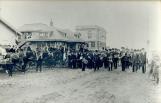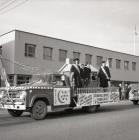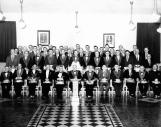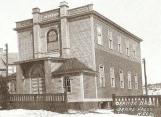1
Great War Veterans' Association (Branch 12, Royal Canadian Legion)The earliest records indicate that the Great War Veteran's Association (GWVA) was functioning in Grand Falls in the fall of 1919, with members paying dues and buying lapel pins, thus, making it one of the oldest ex-service organizations in Canada.
The first president of the organization was Frank Hopson from 1919 to 1921, and then there was a period during the strike at the A.N.D. Company mill when L.R. Cooper exercised a sort of trusteeship. In 1922, the Grand Falls organization was officially incorporated as a branch of the Great War Veterans Association.
The main focus of the branch was the welfare of the disabled and needy veterans and their families. Every year the branch conducted Poppy and Forget-Me-Not campaigns. They also organized Memorial Sunday, Armistice Day Services, and ran the annual Armistice Ball.
When Newfoundland joined Canada, the GWVA merged with the Royal Canadian Legion, which had been formed in 1926 as an amalgamation of several Veterans' organizations. The Grand Falls branch became Branch 12 of the Legion.
Having existed since 1919, and without a permanent home, the new Legion Branch was very happy to accept the A.N.D. Company building at Botwood (called the Cabot Lodge), which, during the war, served as a lounge for transient VIPs travelling to and from Europe via the Pan American Clippers.
A building committee was struck and the Cabot Lodge was dismantled and moved to Grand Falls and reassembled.
2
Great War Veterans' Association (Branch 12, Royal Canadian Legion)1914-1918
Grand Falls-Windsor, Newfoundland, Canada
 Credits:
Credits:Grand Falls Windsor Heritage Society
Royal Canadian Legion
3
The Oddfellows and RebekahsExploits Lodge No. 2N was the first fraternal order in Grand Falls, being instituted on September 9, 1909. The chartered members were G.E. White, Harold Morris, Eldred Sheppard, Joseph W. Bartlett, Chesley Woods and William Noseworthy.
The first Rebekah Lodge for Newfoundland was instituted in Grand Falls on July 25, 1913 under the name of Esperance Rebekah Lodge No. 64.
4
The Oddfellows and RebekahsMay 1915
Stobb's Camp, Scotland
 Credits:
Credits:Grand Falls Windsor, A Place and its People, Published by: Grand Falls-Windsor Heritage Society Inc. 2005
5
Esperance Rebekah Lodge No. 64At the first meeting of the Esperance Rebekah Lodge Branch 64 at Grand Falls, 16 candidates were initiated in the Rebekah Degree with the election of officers took place. The officers were installed on July 13, 1913 by District Deputy Grand Master White and Grand Marshall Porter. Membership fees were set at $1 and annual dues were $1.
As time passed, it became increasingly important for the Exploits Lodge and the Rebekahs each to have their own building. An appropriate committee was formed in 1959, and in August 1961, the present hall was officially opened and dedicated by the Grand Master Brother Aubrey K. McCann, assisted by Past President Nena Anderson.
6
Esperance Rebekah Lodge No. 641968
Grand Falls-Windsor, Newfoundland, Canada
 Credits:
Credits:Grand Falls Windsor Heritage Society A.N.D. Collection
7
Notre Dame Council, Knights of Columbus 2053, Grand FallsIn 1919, a group of Roman Catholic men from Grand Falls travelled to Harbour Grace where the Knights of Columbus (K of C) had been established in 1909. They took their degrees and, on November 23, 1919, formed Notre Dame Council No. 2053 in Grand Falls, just the fourth to be formed in the province.
Notre Dame Council was little more than 12 years old when it was confronted with a major disaster. The old wooden building that housed its operation was levelled by fire on July 25, 1932. In the fire, all records of the Council were lost. The building had been constructed in 1923 and was occupied in 1926 at a cost of $12,000. Not long after the fire, a new building, the present building, a concrete structure, was opened for occupancy on January 25, 1933.
8
Notre Dame Council, Knights of Columbus 2053Early 1900s
Grand Falls-Windsor, Newfoundland, Canada
 Credits:
Credits:Grand Falls Windsor, A Place and its People, Published by: Grand Falls-Windsor Heritage Society Inc. 2005
9
Lodge Northcliffe No. 1086A number of freemasons who had come to Grand Falls for work eventually formed the first Masons' Lodge on May 4, 1911, and Lodge Northcliffe received its charter from the Grand Lodge of Scotland. The new Lodge was named "Northcliffe" after Lord Northcliffe, the founder of the A.N.D. Company and the town of Grand Falls.
The first meeting of the Lodge was held on September 6, 1911, in a room provided by the A.N.D. Company in the old Town Club on High Street.
From the Town Club the Lodge meetings moved to the Orange Hall on Beaumont Avenue and for many years flourished there. The organizations next move was to build its own temple, which eventually took up six building lots on Memorial Avenue. The laying of the cornerstone and dedication of the temple took place on September 14, 1953.
10
Lodge Northcliffe No. 1086Mid 1900s
Grand Falls-Windsor, Newfoundland, Canada
 Credits:
Credits:Grand Falls Windsor, A Place and its People, Published by: Grand Falls-Windsor Heritage Society Inc. 2005
11
The Orange OrderThe Orange Order was a vibrant, colorful and dynamic organization which began as an organization in Grand Falls in 1907, but today no longer operates. It was a brotherhood of Protestant men who looked after the welfare of its membership and offered help in many ways to the people of the community and surrounding area. The group constructed a lodge on Beaumont Avenue in 1935 and the building remains today, but is being used as an apartment building.
12
The Orange OrderEarly 1900s
Grand Falls-Windsor, Newfoundland, Canada
 Credits:
Credits:Grand Falls Windsor, A Place and its People, Published by: Grand Falls-Windsor Heritage Society Inc. 2005
13
Boys' Brigades and CadetsPrior to the outbreak of the First World War, a non-denominational Boy' Brigade was established, whose chief occupations were marching and recreational sports. This group only lasted until the end of the war, when it was disbanded.
In 1922, branches of two long-established St. John's organizations were set up; the Church Lads Brigade (CLB), an Anglican Church group, and the Catholic Cadet Corps (CCC).
The Catholic group had as its first commanding officer, a returned veteran officer, Michael Nugent. This goup paraded in the old Brigade Hall, a former Methodist Church, off High Street. The first commanding officer of the CLB was Major Harry Windeler, a veteran machine gunner who had come to Grand falls after the war ended as the mill engineer with the A.N.D. Company.
14
Boys' Brigades and Cadets1930s
Grand Falls-Windsor, Newfoundland, Canada
 Credits:
Credits:Grand Falls Windsor, A Place and its People, Published by: Grand Falls-Windsor Heritage Society Inc. 2005
Photographer: E.I. Bishop